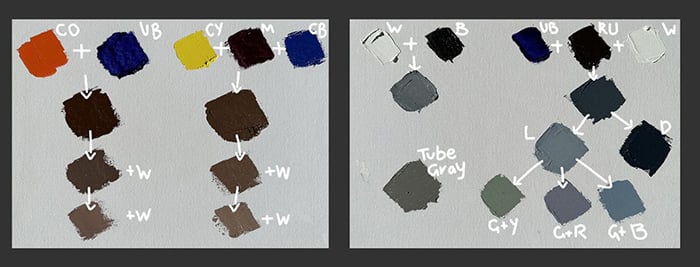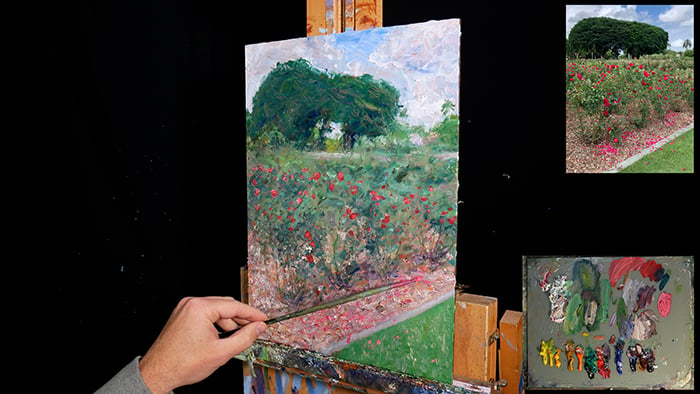NOTE: Enrollment is currently closed. Join the waitlist to be notified when enrollment opens again.
Dear aspiring artist,
Nothing can set an artist apart like skillful use of color. You could build a whole art career around being good with color. Many have—just look at all the top Impressionists.
There’s also nothing quite like the feeling when you place a color on the canvas and it just works. Magical things can happen when you place the right colors together. You’ll know what I mean if you’ve ever witnessed the work of Velázquez, Monet, or van Gogh in person.
But it’s not easy. The world of color is remarkably complex and filled with tricks and illusions. Not to mention we are all flooded with information, much of which is misleading, confusing or downright wrong.
Introducing Color Masterclass
Color Masterclass is a deep-dive on color and how you can use it to create better art. Over the next several weeks, we will explore what color is and why it works the way it does, how to mix and manipulate it, how to make good color decisions, and what the most effective color techniques are and how to perform them.
We have taken all the complexity and confusion of color and distilled it into something clear, concise, and practical for you as an artist.
By the end of the course:
- You’ll have a better understanding and appreciation of color.
- You’ll be able to mix and manipulate color with control.
- Your paintings will be more impressive and you’ll be able to make the colors really “pop”.
- You’ll be able to look at your favorite paintings and know what makes the colors tick.
- You’ll have a better appreciation of color in general.
- You’ll be a better observer of the world around you and you’ll be able to notice subtle relationships and nuances that will stay hidden to others.

Hi, I’m Dan Scott
I’m the artist behind Draw Paint Academy, which I run with my wife Chontele. For the last seven years, we have dedicated our lives to helping aspiring artists.
Color is fascinating, but it’s also frustratingly complex. I created this course to share what I’ve learned about color so that you can progress faster and more efficiently. I also want you to avoid the mistakes I have made along the way. In my early years, I tried to learn color through trial and error. I would make a few dabs on the surface, see if it worked, then go from there. This will only get you so far. I could have saved myself time and frustration by learning the theory behind color and why it works the way it does.
I also want you to have more fun doing it. Color is one of those areas where the more you learn, the more enjoyable it becomes as you gain control and understanding. You go from guesswork and confusion to gaining control over what you’re doing and understanding why it works.
I’m passionate about this stuff and I hope that I can share some of it with you. It really is an exciting area to throw yourself into.

Course Structure and Highlights
In terms of course structure, here’s what you can expect:
- This is an online learning experience with five core modules: Color Basics, Light and Color, Observation, Advanced Saturation, and Color Techniques, plus the Resource Hub.
- The lessons are mostly text and image-based, with videos and links to other resources to supplement as needed.
- Each module includes a comprehensive painting exercise to help you put what you learn into practice along with several mini-exercises throughout. The only exception is Module 1, which has a 10-part quiz to test your understanding of the fundamentals.
- At the end of Modules 2 and 3, you will be able to test your knowledge with a quiz. You can revisit the quizzes as often as you like.
- You’ll get a chance to share your attempt at the exercises with other students (or you can keep it to yourself if you prefer). You’ll also get to see how I went.
- We will start with the basics and get progressively more complex from there. The first module will bring everyone up to speed and make sure we’re all on the same page. Then we will explore more challenging areas together.
- All exercises and quizzes are optional but encouraged. It is also a judgment-free zone, apart from constructive and helpful criticism. So no need to feel embarrassed about sharing your work!
- Each lesson will have a comment section for you to chat with other students and share your thoughts or questions. We will also be monitoring the comments and responding as needed.
- I suggest a week or two for each module, but you can go through as fast or slow as you like. You have lifetime access to all the content, so no rush.

Module 1: Color Basics


Module 2: Light and Color
This module is a deep dive into light and how it determines the colors we see. You’ll learn:
- What light is and why it’s inseparable from color. Most people take light for granted and have never stopped to ponder what it truly is. After this module, you’ll be one of the few who know the answer.
- What the color temperature of light means and why it’s one of the most influential factors in painting. If you’re unaware of color temperature, this lesson will have a profound impact on you as an artist.
- How to capture the subtle effects of secondary light sources and reflected light. You’ll also learn how to do this without compromising the major lights and shadows.
- The three key factors that influence our perception of reflected light.
For the module exercise, we will paint a still life illuminated by different types of light. This will be a fun and challenging exercise to put what you learn about light and color into practice.

Module 3: Observation
This module is all about seeing clearly and noticing what’s around you. Too many artists overlook this, despite it playing such a pivotal role. Every painting starts with observation and if you want to be a great painter, you must be a great observer. You’ll learn:
- How to be a better observer. If you can master observation, you’ll never be short of inspiration.
- What we artists can learn from children.
- Why color is not always as it seems. The world is filled with color tricks and illusions.
- Why our brain’s perception system can sometimes work against us as artists.
- When you should ignore what your eyes are telling you and trust your initial thoughts.
- Why every painting looks wrong at some point in the process, even when you made all the right steps.
- Why you don’t need to invent your own color themes and who you should turn to for inspiration.
- My observation rules of thumb for common subjects.
- How to use color studies to capture and document your observations. Your observations are fleeting and there’s no better way to capture them than through color studies.
In the module exercise, we will venture into nature and document our observations using color studies. This exercise is best done plein air (outdoors) but I’ll also provide you with reference photos if you would rather paint in your studio.

Module 4: Advanced Saturation
This module will cover some of the more advanced aspects of saturation. If you want to make your colors “pop”, you’ll enjoy this one. Here’s what you’ll learn:
- Why it’s helpful to break saturation down into categories.
- The difference between saturation and chroma.
- What the Munsell Color System is and the key findings you should know.
- That colors are not all equal. Some colors are naturally more brilliant than others.
- Why it’s so difficult to translate vivid and highly saturated colors into value and what you can do about it.
- Why more color isn’t always better and how you can do less with more.
- Why grays and browns are the unsung heroes of painting and how to use them effectively.
- Why there’s no such thing as beautiful or ugly colors.
In the module exercise, we will create a painting that showcases saturation contrast. You’ll be able to follow my lead or choose your own subject to paint.


Module 5: Color Techniques
The final module will give you practical techniques to get the most out of your colors. This is all about taking the theory you learned from the earlier modules and learning how to apply it in your paintings. You’ll learn:
- Multicolored strokes, broken color, and pointillism. These are some of my favorite techniques. With just a few strokes, you’ll be able to convey a lot of information about the subject.
- That you don’t need to cover the entire surface with color and why it can be more effective to leave parts of the white surface exposed.
- How to seamlessly transition from one color to another without using hard edges.
- How to create subtle color links between different parts of your painting. This will give your work a sense of harmony and coherence.
- What it means to paint within a compressed value range and why it’s so effective.
- How to inject life and variance into your work without compromising its fundamental value structure.
In the final exercise, you’ll get a chance to test one or more of these techniques out in a painting.


The Resource Hub
We have curated some of the most helpful websites, readings, and other external resources to support your learning. There’s no shortage of information out there about color, but good and reliable information is hard to come by. Our resource hub will point you in the right direction.
There’s also a gallery of master paintings that demonstrate particularly stunning use of color, a list of master artists to explore, and a list of quotes by famous artists providing their thoughts on color.

What to Expect Once You Enroll
Once you enroll, you’ll get an email welcoming you to the course and providing you with the next steps. If you’re new here, we will set you up with an account and you’ll receive a separate email prompting you to set a password.
You’ll be able to access the course from your student dashboard. This is an online portal that you can access from any device, as long as you have an internet connection.
You’ll have immediate and lifetime access to all the course content. We will also use email to guide you through the course and provide additional information as needed.
If at any point you have questions or need help, we will be happy to help.

This Will Be for You If...
- The colors in your painting appear flat, muddy, or uninspired.
- You want to know why color works the way it does rather than trying to trial and error your way through.
- You want to be able to look at your favorite paintings and explain why they work and why they appeal to you.
- You want to gain a better appreciation of color in art and in general.
- You want to learn how to make your colors "pop" in your paintings.
- You want to learn control and restraint with your use of color.
- You want to learn the beautiful dance of color mixing.
Suitable for All Traditional Mediums That Use Color
I use oils, but the course is suitable for any medium that uses color (acrylic, watercolor, gouache, pastel, colored pencil, etc.).
Your Tough Color Questions Answered
All lessons have a comment section where you can leave any questions about color. Chontele and I will be available to answer these questions. Other students might also lend a hand. You can also email us directly if you need help.
What About Critiques?
The course is designed to be self-study, but I will personally critique your final exercise submission. You'll also be able to see how other students go in the student galleries. Here's a sneak peek at the student gallery for the Module 2 exercise:

Testimonials
"I have been missing so much by not having this knowledge. Talent without training is only potential. Talent and training is a path to success. You think you’re an artist? Take this course to find out." - B Wagner
"Enrolling in the Color Masterclass has been very beneficial and rewarding for me, elevating my expertise to new heights and introducing a profound third dimension to my comprehension of colors and the art of painting. The comprehensive insights and techniques acquired have undeniably enriched my artistic journey." - J Eliav
"I loved this course. I learned so much about color....so many AH HA moments!!! No book has explained COLOR so clearly before and I have read a LOT! I will be rereading this course again and again.... its been a blessing to take it Dan. Thank you so very much!" - J Rose
"Most of all the theory and examples are excellent and the exercises kept me engaged thoroughly. I learned very deeply, probably through the exercises. Funny how we hear information about how to paint but it is only when we are fully awakened to a particular situation that we take in the new ways of observation. I now look for primary, secondary, and reflected lights. I benefited from taking the course at my own pace. All in all a terrific course!" - B Terrien
"I enjoyed this course, it is well structured and I have learned a lot. I will surely come back to it now and then to refresh my memory. Love it." - C Cheung
"The course is clearly laid out into segments that are defined with clear explanations, multiple examples and exercises. It was easy to follow for beginners like me and was certainly worth doing. I learnt a lot. Not only that, but I now have a resource library to draw from." - L O'Regan
"I thoroughly enjoyed this course; Dan is a teacher who speaks to me!
The modules were informative and well thought out. The exercises were helpful and doable! And I want to turn them into daily exercises/warm-ups.
Most importantly, this course got me painting more. I will continue to "play" with my watercolors but, down the road, I would like to revisit this course using a different medium." - A McCall
"It covered so much more than l expected. I’m hoping I can improve my painting over time by using the techniques and having them become second nature." - D Weisman
"I really enjoyed the course Dan, I found it very helpful. Thank you. I look forward to putting all the information to good use!
I find colour so challenging, warm, cool etc, so I feel I need to have my own "go to charts" for reference. Often when I paint, creating the colours is the hardest part, hence why I studied the course.
Thanks again Dan, keep the great work up!" - R Weaver
"I was very impressed with this course, especially the module on the light sources. I try to remember shadows, but sometimes forget about the secondary light source." - S Gibbons
"Not only was the course extremely informative, but it was FUN! I learned many new techniques and creative ways to express myself. Thank you so much." - C Gussler
"I loved every minute. Many thanks for such a complete series of lessons. It took a great deal of time for you to construct this site and it is appreciated." - D Hicks
"I liked the clear explanations, relevant exercises and the motivation to complete them, videos, the chance to get personal feedback and share work. Areas I knew about were refreshed and enhanced, the new ideas will change my style.
Above all, I was pleased with the final exercise which really encouraged me to deliberately try out a load of new techniques which I was pleased with and will definitely use again - thank you!" - J Ashworth
"This course was great fun! I can't wait to see how my work is going to be affected by the techniques I've just learned. Many thanks to the two of you" - S Purinton
"Color theory is daunting. Just take a look around your environment. Colour is everywhere. I approached this course with the attitude that I really did not know much about color. This in turn allowed me to embrace this course and my knowledge of colour theory expanded exponentially. I am truly amazed at the volume of information that Dan compiled, I for one am truly thankful for for all of it." - S Handley

Frequently Asked Questions

My 100% Guarantee
Your satisfaction is my number one priority. If for any reason you do not enjoy the course, just send me an email within 60 days of purchase and I will refund you in full.
NOTE: Enrollment is currently closed. Join the waitlist to be notified when enrollment opens again.
If you have any questions, you can email me at admin@drawpaintacademy.com.
